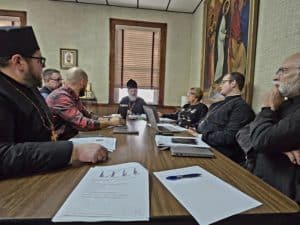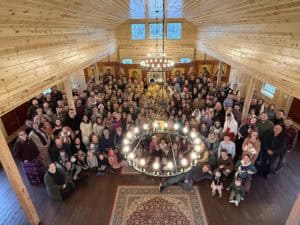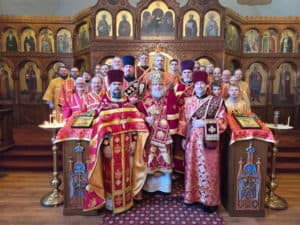CHRIST IS RISEN!
I assume you have all had a chance to review the 5-1-2020 Pastoral Letter of the Holy Synod and the accompanying directives from the Synod. If not, you can find them on the OCA and our own Diocesan websites. The pastoral letter is for the entire faithful. The Synodal directives are largely for Diocesan leadership (Clergy, and parish councils) to assist them in implementing those directives and those I will be sharing in this letter. The Synodal directives are detailed and clearly speak on how we might go about opening up our parishes. The Synod (as the basis of its directives) adopted the White House Plan “Opening Up America Again”. It is a three-phase approach to re opening our churches; the Synod added some sub stages to provide greater flexibility to the Diocesan Bishop. These can found in the Synodal Directives document. I want to speak on several items that I consider to be crucial in moving forward.
The following gating criterion needs to be met before entering the 1st phase that allows 10 people to attend services at church.
- Symptoms
- Downward trajectory of influenza-like illnesses (ILI) reported within a 14-day period.
- And, a downward trajectory of covid-like syndromic cases reported within a 14-day period.
- Cases
- Downward trajectory of documented cases within a 14-day period.
- Or, a downward trajectory of positive tests as a percent total of tests within a 14-day period (flat or increasing volume of tests)
- Hospitals
- Must be able to treat patients without crisis care, and
- There must be a robust testing program in place for at-risk healthcare workers, including emerging antibody testing
The Federal guidelines go on to say:
“All individuals, WHEN IN PUBLIC (e.g., parks, outdoor recreation areas, shopping areas), should maximize physical distance from others. Social settings of more than 10 people, where appropriate distancing may not be practical, should be avoided unless precautionary measures are observed. Avoid SOCIALIZING in groups of more than 10 people in circumstances that do not readily allow for appropriate physical distancing (e.g., receptions, trade shows)”
This above statement seems to imply that in larger church spaces (that can easily seat 100+ with room to spare), more than 10 might be allowed to gather if the appropriate precautions are taken. Be advised that any state directives that do not allow religious gatherings for more than a specific number of people must be adhered to, until those limits are lifted or modified. Clergy are not to make any decision on this without discussing their plans with me to obtain a blessing.
I know some state directives exempt religious gatherings, others limit them to 10, and others may be allowing 15 to 20. We on the Synod thought it important to heed the spirit of these directives in the interest of the public welfare. As the Synod has adopted this plan with modifications, it means the gating criterion is also a part of it. Every parish priest needs to research the above three criteria relative to their county/region and be able to inform me that the above county or regional criteria has been achieved (providing documentation) before I will bless 10 people (including the priest and family) to attend services. These gating criteria need to continue to be met for another two weeks in order to go to Phase Two, which allows for up to 50 people to attend services. Again the priest would need to contact me for a blessing to go to Phase Two and provide the necessary documentation to show the parish is ready for that. Should the data on the above spike and go up then it is back to pre Phase One conditions.
Until, Phase One is reached; I will bless 5 people to attend current services. All services can now be done at the church. I will also bless a priest to serve multiple liturgies during the week to allow for more to attend church and receive the sacrament (i.e. Sunday, Wednesday, Saturday). As the numbers who attend increase it is important that a way of determining who attends is important. Except for the priest and choir director/chanter, no one should be signing up to attend three liturgies in a week. During this 5-person limit, it would still make sense to keep the church door locked with the appropriate sign posted as I mentioned in my last directive.
The question remains as to how to handle the doors when you hit 10 or more people. A parish needs to have a plan developed as to how to address this and present it to me. This should include a sign posted on the doors that cautions people about the risk of entering church given the current pandemic. The Synodal guidelines offer some direction here. In these small gatherings live streaming the services should still continue. Once the doors are opened, then bells can be rung for the services. Finally thought needs to be given as to how people will leave the church when the service is over. It is important that people refrain from congregating on church property to initiate an informal social hour.
Proper cleaning of church
This is to be done after every service; please look to the Synodal directives for the details regarding what is to be cleaned. Please follow those directives so that when I am contacted for a blessing to move to Phase One, the parish priest can assure me a plan for cleaning the church is in place.
Social Distancing and Face Masks
Maintaining social distancing is crucial for us to move forward. Measurements should be taken of the square footage of the worship space to determine how many people can properly social distance. Anyone who does not abide by the social distancing norm will be asked to leave the church (or the priest may stop the service to enforce the distancing norm if it is not being kept). Families with young children can stay together so long as children remain with their parents. The choir/chanters should be a small group with the appropriate distancing to take place among singers. I would think for the first phase, no more than two chanters are sufficient. As the numbers increase, an usher or two may be needed to manage these situations. Finally, if it is just the priest and his family household that are in church, none of the above applies here (including facemasks)
Facemasks
People (except for chanter(s) and celebrant) who attend services are to wear facemasks for now. If someone doesn’t have one, the parish should have a supply on hand to provide people with masks. The priest should perform the proskomedia and administer communion wearing a facemask. There are a number of websites that one can check on regarding how to make inexpensive facemasks. The use of facemasks and the practice of social distancing will be even more important once more people attend services.
Distribution of Communion
The Synod has left it up to the Diocesan Bishop to determine the method of distribution. I will bless the following means to distribute communion on a temporary basis. Two metal spoons may be alternated to give communion. After giving communion, the spoon is to be placed into a glass of Ever Clear alcohol, or an equivalent grain alcohol, then into a glass of hot water to be then wiped on a towel. You can follow the same procedure with the second spoon. (You probably would leave the one spoon in the alcohol until you have communed with other spoon, then place that spoon in the alcohol and remove the other one and dip that into the hot water and dry with towel and commune the next person). For the time being use of the communion cloth and servers to hold it will be discontinued. A good quality paper towel should be given to the communicant to receive and wipe his or her mouth. The paper towels will be disposed and then burnt. Great care needs to be taken to prevent any spillage of the sacrament. A glass of new alcohol should be used at the following service.
Communion lines should maintain a 6 feet spacing. (Zapifka can only be offered in individual plastic cups and/or an altar server wearing proper gloves can give antidoron). If the priest decides to forego both Zapifka and antidoron for now, I have no problem with that.
Baptisms, Chrismations, and Weddings, and Funerals
All of these can be done provided you are functioning within attendance guidelines of the Diocese and the State. In the case of funerals, the priest also needs to cooperate with the expectations of the funeral home/cemetery. This poses concerns for those who want to have large groups at these occasions. It they can’t wait, do the Baptism/Chrismation within the current limits and postpone the reception party to a later time. The same would apply with weddings.
Special consideration needs to be given at Baptisms and Weddings where social distancing cannot be maintained during parts of the service. In this area contact me to discuss how to address this.
Confession
Confessions can continue either through Skype, or phone. It may also be done person to person by maintaining social distancing, or both the priest and the one who confesses wear a facemask. Absolution can be via media (if it is not feasible to get to church) and in person.
Visitation of the sick and taking reserve sacrament
The guidelines for visitation of the sick and communion are still in place as described in my March 24, 2020 letter (#48),
Church School and Coffee Hour
This is to remain as is; no in person church school or coffee hour. Both can take place via Zoom meetings. Depending on how things look in September, hopefully these can resume then.
This letter is not a one-size fits all approach. Some areas where the virus is not as prevalent can begin the Phase process sooner. Some churches have larger worship spaces; others will be hard pressed to social distance with just 15 to 20 people. I don’t know of any directive that has stated social distancing is optional or unnecessary. Some areas will be able to go to Phase One sooner than others and move quicker to Phase Two and Three.
Finally I ask your forgiveness but I have to confess to some worries. There seems to be more concerns being raised that we are overreacting to this pandemic; that many of the methods being used to address this are not necessary. The Holy Synod or myself do not share that sentiment. What I do like about the Federal “Opening up America Again” plan is that it gives some objective criteria to move ahead.
As to social distancing, facemasks, and communion distribution, consider this a discipline we are following to enable more people to come to church and hopefully get to a larger number sooner rather than later, but frankly I don’t have a clue as to when that will be. All the camp programs for the summer have been canceled in our Diocese and in other jurisdictions. It is simply so because the camps are unable properly protect campers and staff from potential infection from the virus given the large number of campers (who also travel across state lines). But my most important concern with utilizing the above is to minimize the risk of bringing harm to others.
So we are moving forward but, more at 10mph pace. In Chicago we accept that as a fact of life when it comes to driving the freeways in the morning and evenings. (Although I have to admit, when I do go out the few times I do, driving is much easier!) So I ask you to be patient and endure. We will move on and hopefully be in better place by September God willing.
Christ is Risen!
With love in Christ, the unworthy +Paul
Please review a diary of Bishop Pitirim of the Moscow Theological Academy in Sergiev Posad who had the virus and how it impacted on the Academy and the St. Sergius Holy Trinity Lavra over the last month.



